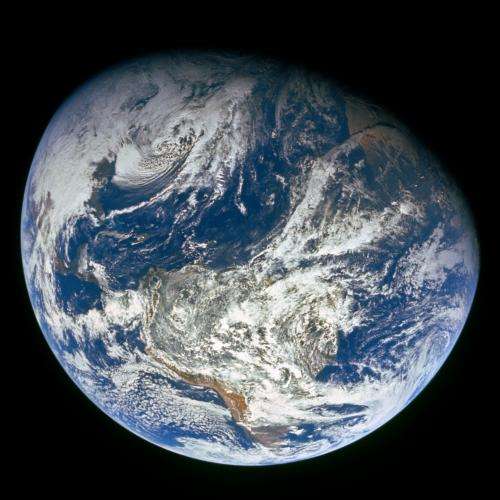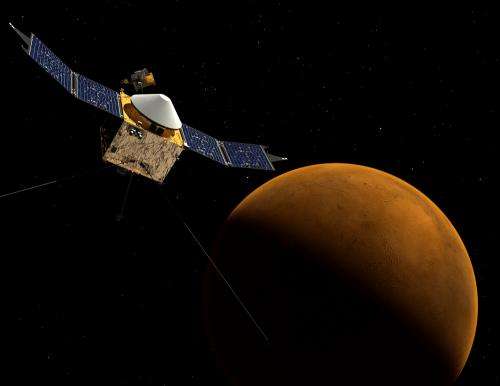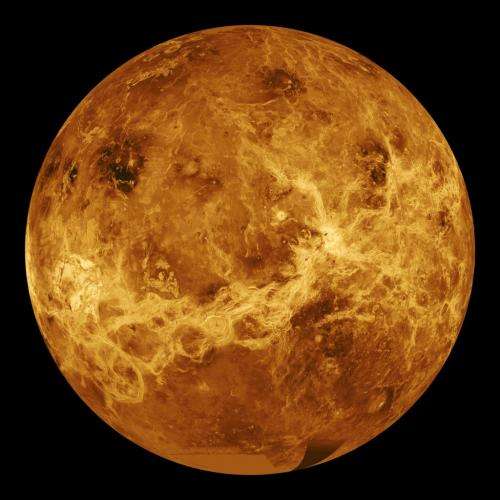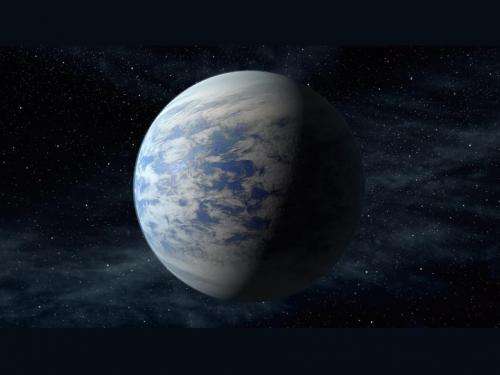Planetary atmospheres a key to assessing possibilities for life

A planetary atmosphere is a delicate thing. On Earth, we are familiar with the ozone hole—a tear in our upper atmosphere caused by human-created chemicals that thin away the ozone. Threats to an atmosphere, however, can also come from natural causes.
If a big enough asteroid smacks into a planet, it can strip the atmosphere away. Radiation from a star can also make an atmosphere balloon, causing its lighter elements to escape into space.
Understanding how permanent an atmosphere is, where it came from, and most importantly what it is made of are key to understanding if a planet outside our solar system is habitable for life. Our instruments aren't yet sophisticated enough to look at atmospheres surrounding Earth-sized planets, but astronomers are starting to gather data on larger worlds to do comparative studies.
One such example was recently accepted in the journal Astrophysical Journal and is available now in a preprint version on Arxiv. The astronomers created models of planetary formation and then simulated atmospheric stripping, the process where a young star's radiation can push lighter elements out into space.
Next, the team compared their findings to data gathered from NASA's planet-hunting Kepler Space Telescope. The researchers predict that the atmospheric mass of the planets Kepler found is, in some cases, far greater than the thin veneer of air covering Earth.
Co-author Christoph Mordasini, who studies planet and star formation at the Max Planck Institute for Astronomy in Heidelberg, Germany, cautioned there is likely an observational bias with the Kepler data.
"Kepler systems are so compact, with the planets closer to their star than in our solar system," said Mordasini.
Astronomers are still trying to understand why.
"Maybe some of these objects formed early in their system's history, in the presence of lots of gas and dust," he said. "This would have made their atmospheres relatively massive compared to Earth. Our planet probably only formed when the gas was already gone, so it could not form a similar atmosphere."
Blowing gas away
Planetary systems come to be in a cloud of gas and dust, the theory goes. If enough mass gathers in a part of the cloud, that section collapses and creates a star surrounded by a thin disk. When the star ignites, its radiative force will gradually clear the area around it of any debris.

Over just a few million years, the hydrogen and helium in the disk surrounding the star partially spirals onto the star, while the rest gets pushed farther and farther out into space. Proto-Earth likely had a hydrogen-rich atmosphere at this stage, but over time (with processes such as vulcanism, comet impacts, and biological activity) its atmosphere gradually changed to the nitrogen and oxygen composition we see today.
Kepler's data has showed other differences from our own solar system. In our own solar system, there is a vast size difference between Earth and the next-biggest planet, Neptune, which has a radius almost four times that of Earth's. This means there's a big dividing line when it comes to size between terrestrial planets and gas giants in our solar system.
In Kepler surveys (as well as surveys from other planet-hunting telescopes), scientists have found more of a gradient. There are other planetary systems out there with planets in between Earth's and Neptune's sizes, which are sometimes called "super-Earths" or "mini-Neptunes." Whether planets of this size are habitable is up for debate.
"The gap between the Earth's and Uranus' or Neptune's size, and also in their composition, doesn't exist in extrasolar planets. So, what we see in the Solar System is not the rule," Mordasini said.
The planets that Kepler has picked up, however, tend to be massive and closer to their star, and are therefore easier to detect. They pass more frequently across the face of their parent star, making them more easily spotted from Earth.
The size implies that they managed to grab their disk's primordial hydrogen and helium atmosphere before it got blown away. Hydrogen and helium are light elements, so a star's radiation would puff up the hydrogen and helium atmosphere far more than what we see on Earth, with its heavier elements.
What does this mean? The team predicts that in some cases, when astronomers measure the radius of a planet, that measurement also includes a bulky atmosphere. In other words, the planet underneath could be a lot smaller than what Kepler's measurements could indicate.
This process assumes that the planet has an iron core and silica mantle, just like the Earth, but orbits its parent star about 10 times closer than we do ours. If the atmosphere is more massive—even 1 percent of the planet's mass is many thousands of times more massive than Earth's—it creates more pressure on the surface.
"It depends, but you can imagine this pressure is comparable to the deepest parts of the Earth's ocean. Additionally, these atmospheres can be isolating and insulating for heat, so it's also very hot on the surface," Mordasini said.

High temperatures on Earth are known to destroy amino acids, the building blocks of carbon-based life.
Delicate atmosphere
The atmosphere may be more massive, but it is also delicate. It wouldn't take too much of a push to send hydrogen, the lightest element, away from the planet and into space.
Young stars like the Sun in its youth are especially active in x-rays and ultraviolet radiation. When these forms of light hit a planetary atmosphere, they tend to heat it up. Since heating expands gases, the atmosphere grows. An atmosphere that flows beyond certain heights can get so high that part of it gets "unbounded" from the planet's gravity and escapes into space.
In our own solar system, for example, Mars likely lost its hydrogen to space over time while a heavier kind of hydrogen (called deuterium) remained behind. A new NASA orbiting spacecraft called Mars Atmosphere and Volatile Evolution (MAVEN) has just arrived at the Red Planet to study more about atmospheric escape today and researchers will to try to extrapolate that knowledge to space.

By contrast, the planet Venus is an example of having an exceptionally persistent atmosphere. The mostly carbon dioxide atmosphere is so thick today that the planet is completely shrouded in clouds. Underneath the atmosphere is a hellish environment, one in which the spacecraft that have made it there have only survived a few minutes in the 864 º Fahrenheit (462 º Celsius) heat on the surface. It is widely presumed that atmospheres like that of Venus would be too hot for carbon-based life.
Why Venus, Mars and Earth are so different in their atmospheric composition and history is among the questions puzzling astronomers today. Understanding atmospheric escape on each of these worlds will be helpful, scientists say.
"How strong atmospheric escape is depends on fundamental properties such as mass or planetary orbit," Mordasini said. "We found out for giant planets like Jupiter, the operation is typically not as strong."
Future work of the team includes considering atmospheres that are not made of hydrogen or helium, which could bring researchers a step closer to understanding how different types of elements work on planets. Eventually, this could feed into models predicting habitability.
More information: "Planetary population synthesis coupled with atmospheric escape: a statistical view of evaporation." arXiv:1409.2879 [astro-ph.EP] arxiv.org/abs/1409.2879
Journal information: Astrophysical Journal , arXiv
Source: Astrobio.net
This story is republished courtesy of NASA's Astrobiology Magazine. Explore the Earth and beyond at www.astrobio.net .

















